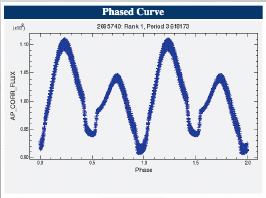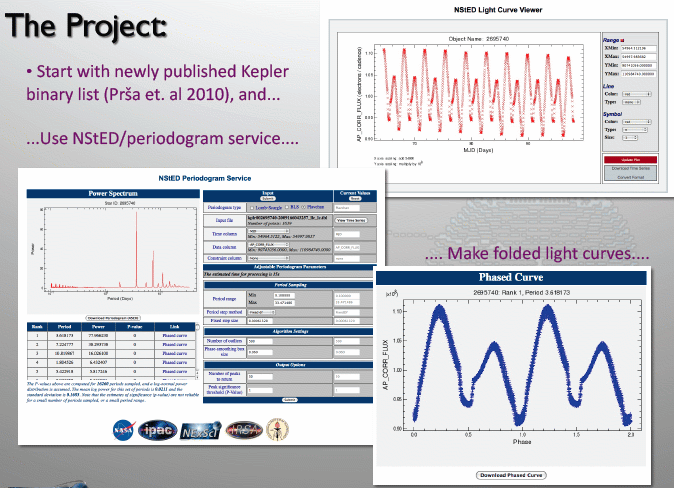Difference between revisions of "Measuring eclipsing binaries in the Kepler data set"
m |
m |
||
| Line 17: | Line 17: | ||
==Outline== | ==Outline== | ||
| − | Start with newly published Kepler binary list (Prsa et al. 2010) and use the [[What is a periodogram? | NStED periodogram service]] to investigate the light curves and make folded light curves (e.g., plot the light curve against orbital phase rather than time). | + | Start with newly published Kepler binary list ([[http://adsabs.harvard.edu/abs/2010arXiv1006.2815P Prsa et al. 2010]]) and use the [[What is a periodogram? | NStED periodogram service]] to investigate the light curves and make folded light curves (e.g., plot the light curve against orbital phase rather than time). |
[[image:binary3.gif]] | [[image:binary3.gif]] | ||
You can use 'Binary Maker' software to investigate effects of different parameters on the light curve models. (e.g., you can create a system of a particular mass ratio, separation, eccentricity, and inclination to line of sight to see if it matches your observed light curve.) | You can use 'Binary Maker' software to investigate effects of different parameters on the light curve models. (e.g., you can create a system of a particular mass ratio, separation, eccentricity, and inclination to line of sight to see if it matches your observed light curve.) | ||
Revision as of 02:58, 12 August 2010
Based on materials originally developed by Julian van Eyken (NStED/IPAC) for the 2010 Sagan Exoplanet Workshop. This group project was entitled "Measuring Eclipsing Binary Star Parameters from Kepler Data."
Introduction
Binary stars are ubiquitous -- only ~50% of stellar systems are single stars. People study binary systems to better understand stellar parameters (mass, radii, distances, etc.) Without binary stars, many of these "fundamental parameters" are uncalibrated, e.g., many of these measurements can only be done in binary systems. Planetary transits are "special cases" of binary transits, where the secondary companion is much less massive than the primary. Binary light curves often have a lot more structure than planetary transit light curves; see figures.
 Eclipsing binary in Kepler data.
Eclipsing binary in Kepler data.
 Planetary transit in Kepler data.
Planetary transit in Kepler data.
Project Goals
Learn about:
- What types of light curves come from what kind of binaries.
- What properties can be determined from light curves.
- How those properties are related to light curves.
- How well properties can be determined (what kinds of degeneracies/ambiguities are present).
Outline
Start with newly published Kepler binary list ([Prsa et al. 2010]) and use the NStED periodogram service to investigate the light curves and make folded light curves (e.g., plot the light curve against orbital phase rather than time).
You can use 'Binary Maker' software to investigate effects of different parameters on the light curve models. (e.g., you can create a system of a particular mass ratio, separation, eccentricity, and inclination to line of sight to see if it matches your observed light curve.)
